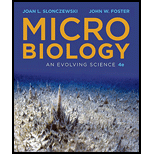
Concept explainers
To review:
The bacterial features that can be studied by the following techniques of microscopy: light microscopy, fluorescence microscopy, scanning electron microscopy, transmission electron microscopy.
Introduction:
The human eye can resolve things that are up to 1 millimeter in size. In order to resolve the objects below this size, human eyes need equipment that has greater resolving power. Microscopes are equipment that are used to imagine the objects that cannot be resolved by the eyes.
There are various types of microscopes that are used for imaging the bacteria and other microscopic entities. All microscopes operate on the same principles of physics, refraction of light leading to magnification. The illumination and magnification in several microscopes can be obtained from the light while some use electron beams. The bacterial features that can be studied by the above-mentioned techniques of the microscopy are listed below:
1. Light microscopy: The shape of the bacteria can be revealed by using light microscopy. The bacteria that form the chain can also be detected using this technique. The cell wall of the Gram-positive and Gram-negative bacteria can also be examined under light microscopy.
2. Fluorescence microscopy: Fluorescent dyes are used in this technique. These dyes can bind up with the specific macromolecules present in a particular region of the cell. Thus, the specific position of the organelles can be revealed by this technique. This technique can also be used to trace various ongoing biological processes in the cell-like replication.
3. Scanning electron microscopy : A beam of electron is used in this technique in order to magnify the image. It can help in detecting the surface details of the bacteria. The composition of the external surface of the cell can be revealed by this technique.
4. Transmission electron microscopy: This technique is similar to the bright light microscope except for an electron source from a tungsten filament instead of a light source. It is used to reveal internal details of microorganisms like the presence of flagellum. The cell organelles can also be revealed by using this technique of microscopy.
Want to see the full answer?
Check out a sample textbook solution
Chapter 2 Solutions
Microbiology: An Evolving Science (Fourth Edition)
- Describe the principle of homeostasis.arrow_forwardExplain how the hormones of the glands listed below travel around the body to target organs and tissues : Pituitary gland Hypothalamus Thyroid Parathyroid Adrenal Pineal Pancreas(islets of langerhans) Gonads (testes and ovaries) Placentaarrow_forwardWhat are the functions of the hormones produced in the glands listed below: Pituitary gland Hypothalamus Thyroid Parathyroid Adrenal Pineal Pancreas(islets of langerhans) Gonads (testes and ovaries) Placentaarrow_forward
- Describe the hormones produced in the glands listed below: Pituitary gland Hypothalamus Thyroid Parathyroid Adrenal Pineal Pancreas(islets of langerhans) Gonads (testes and ovaries) Placentaarrow_forwardPlease help me calculate drug dosage from the following information: Patient weight: 35 pounds, so 15.9 kilograms (got this by dividing 35 pounds by 2.2 kilograms) Drug dose: 0.05mg/kg Drug concentration: 2mg/mLarrow_forwardA 25-year-old woman presents to the emergency department with a 2-day history of fever, chills, severe headache, and confusion. She recently returned from a trip to sub-Saharan Africa, where she did not take malaria prophylaxis. On examination, she is febrile (39.8°C/103.6°F) and hypotensive. Laboratory studies reveal hemoglobin of 8.0 g/dL, platelet count of 50,000/μL, and evidence of hemoglobinuria. A peripheral blood smear shows ring forms and banana-shaped gametocytes. Which of the following Plasmodium species is most likely responsible for her severe symptoms? A. Plasmodium vivax B. Plasmodium ovale C. Plasmodium malariae D. Plasmodium falciparumarrow_forward
- please fill in missing parts , thank youarrow_forwardplease draw in the answers, thank youarrow_forwarda. On this first grid, assume that the DNA and RNA templates are read left to right. DNA DNA mRNA codon tRNA anticodon polypeptide _strand strand C с A T G A U G C A TRP b. Now do this AGAIN assuming that the DNA and RNA templates are read right to left. DNA DNA strand strand C mRNA codon tRNA anticodon polypeptide 0 A T G A U G с A TRParrow_forward
 Concepts of BiologyBiologyISBN:9781938168116Author:Samantha Fowler, Rebecca Roush, James WisePublisher:OpenStax College
Concepts of BiologyBiologyISBN:9781938168116Author:Samantha Fowler, Rebecca Roush, James WisePublisher:OpenStax College Principles Of Radiographic Imaging: An Art And A ...Health & NutritionISBN:9781337711067Author:Richard R. Carlton, Arlene M. Adler, Vesna BalacPublisher:Cengage Learning
Principles Of Radiographic Imaging: An Art And A ...Health & NutritionISBN:9781337711067Author:Richard R. Carlton, Arlene M. Adler, Vesna BalacPublisher:Cengage Learning Biology (MindTap Course List)BiologyISBN:9781337392938Author:Eldra Solomon, Charles Martin, Diana W. Martin, Linda R. BergPublisher:Cengage Learning
Biology (MindTap Course List)BiologyISBN:9781337392938Author:Eldra Solomon, Charles Martin, Diana W. Martin, Linda R. BergPublisher:Cengage Learning Biology Today and Tomorrow without Physiology (Mi...BiologyISBN:9781305117396Author:Cecie Starr, Christine Evers, Lisa StarrPublisher:Cengage Learning
Biology Today and Tomorrow without Physiology (Mi...BiologyISBN:9781305117396Author:Cecie Starr, Christine Evers, Lisa StarrPublisher:Cengage Learning





